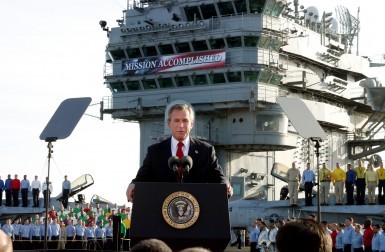The Invasion of Iraq 10 Years After

(AP Photo/J. Scott Applewhite)
Ten years ago, March 19, 2003, President George W. Bush addressed the American people and the world at large. Blinking into the camera, he soberly read these scripted lines: “My fellow citizens, at this hour … American and coalition forces are in the early stages of military operations to disarm Iraq, to free its people and to defend the world from grave danger.”
His announcement surprised no one. In the months prior, his administration had primed the American people and the U.S. Congress for the dark, decade-long misadventure to follow by saturating the media with an unprecedented and relentless media offensive that incorrectly linked Saddam Hussein to 9/11 while raising the specter of mushroom clouds and full-blown nuclear holocaust.
Before the Bush administration’s media onslaught, polls showed that the American people opposed going to war by wide margins. By the night of Bush’s announcement, a public steeped in an untempered and unrelenting war-promotion campaign were not only overwhelmingly in favor of the war, but also incorrectly believed that Saddam Hussein was allied with Osama bin Laden, was sitting on a stockpile of weapons of mass destruction, and suddenly represented a clear and imminent threat to the U.S.
Ten years, hundreds of thousands of American and Iraqi lives, and billions of dollars later, a lot of the same people who backed the war are shaking their heads and rubbing their eyes, looking back on what seems to have been a case of collective hypnosis and wondering how it all happened.
The American people obviously deserve answers. However, they aren’t likely to find them in mainstream media accounts of the 10th anniversary of the war over the days to come — not when these very media outlets were so clearly snowed by the Bush administration.
Progressive media critics like Norman Solomon have been saying for years that there is no way to understand how and why the American people came to enthusiastically support a preemptive invasion of a sovereign nation in direct contravention of international law and professed American values without first recognizing the compliant role the U.S. news media has played in one war after another.
In the documentary War Made Easy, which came out when it was still considered tantamount to treason to question the war in Iraq, Solomon hit rewind and showed the structure and design of the meticulously crafted commercial campaigns for war that U.S. presidents have used to neutralize real journalism and turn American media sources into cheerleaders for war. In this excerpt from the film, Solomon zeroes in on how this worked with the U.S. invasion and occupation of Iraq:

